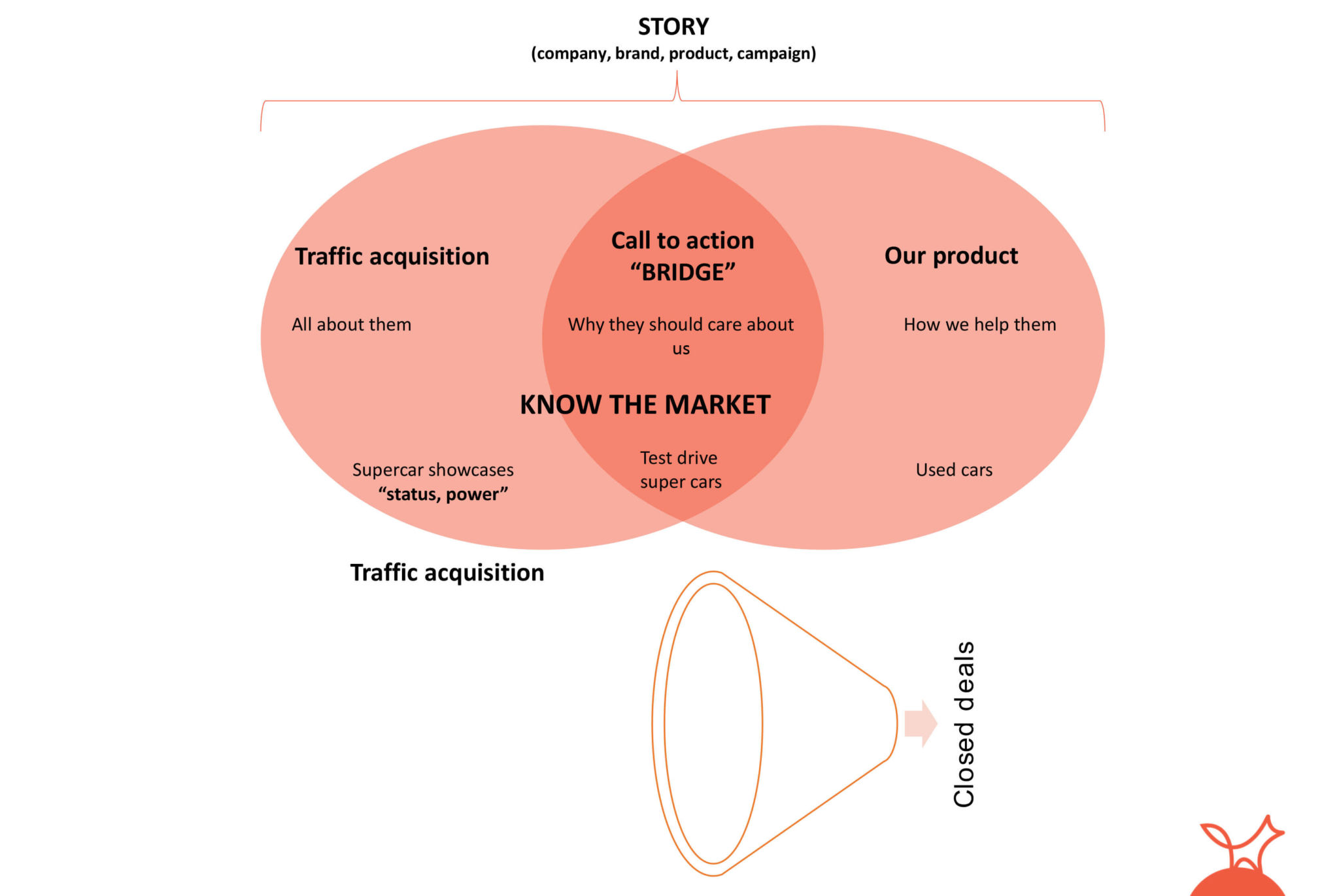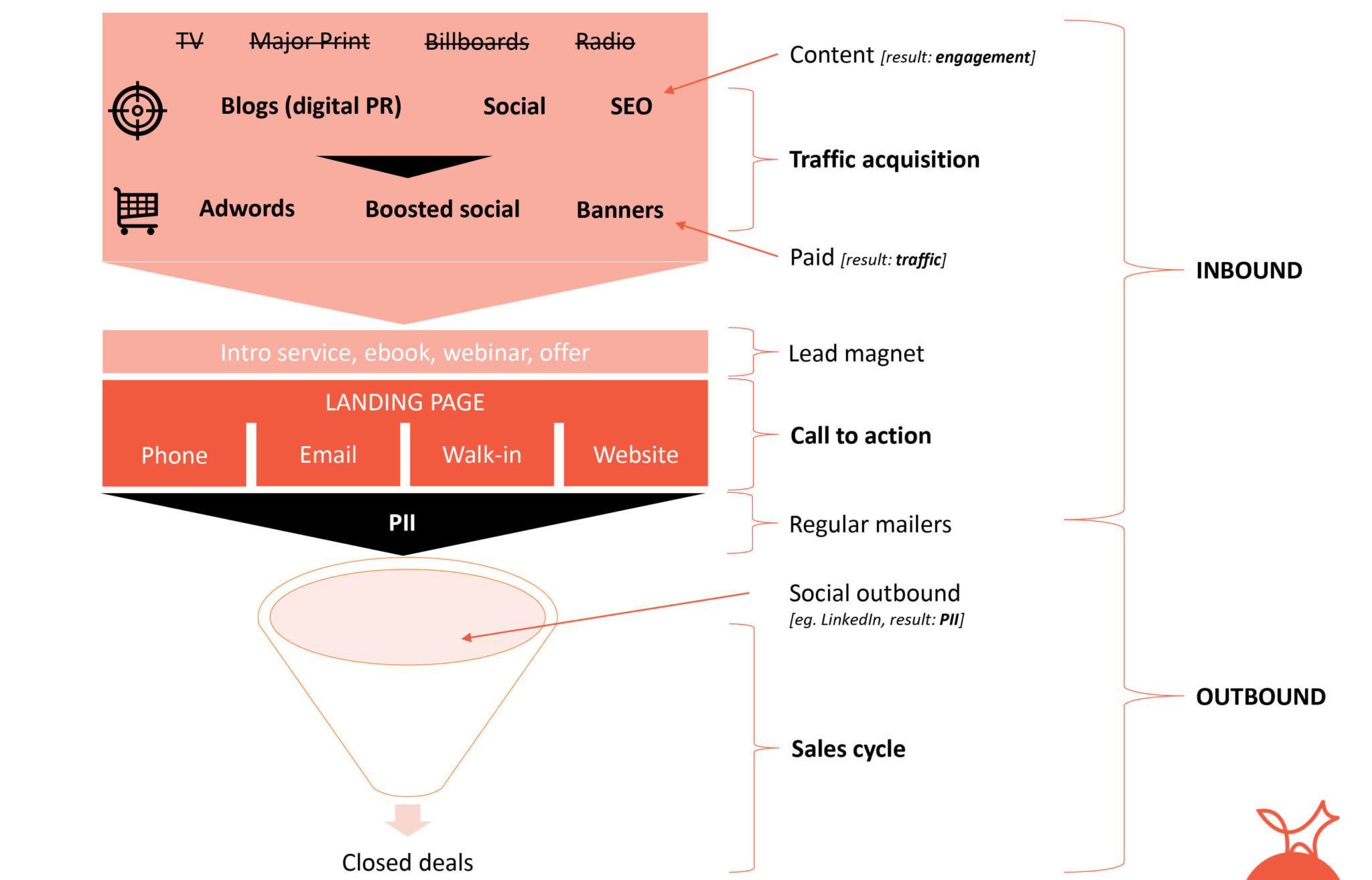
The importance of consistent story from acquiring traffic to making the sale.

Imagine Matt, he’s a used muscle-car salesman. He wants to sell used muscle-cars. He gets decent traffic on his website via word of mouth and through print advertising, but he wants to increase that traffic and turn it into actual sales.round the customer and the marketplace.
Matt isn’t sure where to start. How does he effectively enter a marketplace? How does marketing work in the digital era where options are plenty and bright lights are common place? How does he reach his audience, in particular, in ways that his competitors do not? How does he get his potential customers to want HIM to contact them, rather than waiting for them to simply arrive? Ultimately, how does he make the sale?
Let’s follow Matt through a tried and tested marketing-to-sales flow. This is a flow from digital content to in-person sales. Key to this flow is maintaining a consistent story across the digital and physical realms. This is both very challenging and extremely rewarding.
To maintain a consistent story one must understand what value your business adds to its market place. In addition, one must understand what values your business represents. It is these values that need to be apparent through each phase of the flow. And these values need to be centred not around the business itself, but around the customer and the marketplace.

Traffic Acquisition – The beginning of the story
The inbound engine
Creating a consistent story through quality, appropriate content
The first goal underlying the inbound engine is to reach new eyes, to acquire traffic. The final goal of the traffic acquisition phase is to gain potential customers’ personally identifiable information (PII – their names and contact details). Hence the question: How does Matt get brand-new prospects to want him to contact them?
Before the digital age, print media, TV and radio were the main inbound tools. These were expensive and difficult to track. Today, there are both paid and free inbound engine options. Both should be used, but in different ways.
Paid options are adwords, boosted social and banners. These target people already in the market for the particular service and so can sometimes lead to immediate sales as you are referring directly to your own product.
Free options are blog, social media posts and SEO. These take a longer time (approximately 6 months). Their first goal is engagement which in turn leads potential customers to your landing page.
Importantly, whilst building engagement, the point is not to talk about one’s product or even what one offers to the market. This is simply drawing the eyes of your target community to content they are interested in. This is all about them and not about you. So first, find out who you want to talk to, what drives them and what draws their attention. This research is going to be invaluable in guiding your content strategy.
Our used car salesman knows that his target audience comprises petrol-heads, especially those who cannot afford to buy new muscle cars. So what are their interests? What are their emotional drivers? What makes them tick and what makes them click? What are their conversations around the water-cooler, race track and Whatsapp groups? He goes online and into the field to investigate and he finds they are interested in motor sport, Lewis Hamilton, horsepower and burning rubber.
He then creates quality content that speaks to his target audience. Discussions, images and videos on motor-sport and car engines. This is not the moment to promote oneself or one’s product. This is not the moment to proclaim how cool we are. This is about finding what our target audience already thinks is cool and then entering the conversations that already exist within the given community. This is about being part of the community. Contributing to the community.
Generating engagement takes time but it is wonderfully efficient. Once it starts running, it continues to run without requiring additional resources. You simply study and tweak it to optimise and get better results.without having to pour more resources into that machine. The most powerful thing about an inbound engine is that it just runs. .
Tools
Tools like Spyfu allow you to track the digital strategies of your competitors. This can alert you to your untapped areas and help you to differentiate yourself from your competitors.
Through paid social, Matt has already attracted traffic to his page, and through his engaging social posts, he will slowly continue to grow a more meaningful relationship with people he doesn’t even know. However, he still has not acquired their PII. This is the next phase and will take him to the sales cycle.
There are tools that can enhance the machine. Use Inline Frames (IFrames) to drive traffic to your landing page.
Call to Action – Customers become a part of the story
Lead Magnet within your consistent story
Your landing page is still not your moment to start selling. The goal is acquiring PII. People are increasingly aware of the value of their PII, and suspicious of those who want it. This is why building engagement first is key and showing that you can add value to them is a must. Offering potential clients something (a lead magnet) in exchange for their information is strongly recommended. Can you offer them free webinars, an e-book, free service or discounts? Matt might consider these but finally decides to offer test drives in supercars in exchange for information. This speaks directly to the interests of his customers, and maintains consistency in the story that he has been developing through his content. Petrol-heads gladly give him their PII and now and Matt has now shifted from traffic acquisition, to the sales cycle.
The lead magnet forms a part of your consistent story. Do not offer something unrelated.
Now Matt’s job is to stay in contact. An automated email is the most common way.
Social Outbound
There is a way to circumvent the traffic acquisition phase using social outbound. A way to get PII without the hard work – but note, this is not a silver bullet. Potential customers can be reached on sites like LinkedIn, via an initial outreach on the platform itself. This can be a professional and unobtrusive way to reach new eyes. This can be considered “warm-calling” and is the very thing that has rendered pure cold-calling obsolete. Doing one’s homework is a must before engaging in social outbound.
The major disadvantage of social outbound is that it takes a lot of background work to do well – especially when trying to maintain a consistent story. Hit-rates on generalised, “boilerplate” social outbound produces weak conversion rates. One would usually need a dedicated sales team putting time and energy into engaging people directly using social outbound. If you’re very well resourced from the sales capability point of view then you can flank your inbound with strong social outbound to get PII from two methods, instead of depending on just one. That would be the optimum scenario.
Sales Cycle – the beginning of a new story
Our Product
The sales cycle begins when customers’ PII has been acquired. Your job is now to be in touch with them. The easiest way to stay in touch is by email. Automated mailing systems can be very useful here so that you can stay in touch with the person who just gave you something that’s very precious to them, their PII.
These automated emails should still focus on the customer. What problem are they experiencing? How can we add value to that? And why should they care about us? You only really start talking your product to the customer when your salesperson has secured their first meeting with a customer. They usually do this in person because that’s when he has the person’s attention available to him and it becomes a dialogue. That’s your opportunity to connect with someone more.
With effective training, the values and story that have been maintained throughout the marketing-to-sales flow will be apparent in in-person meetings. This will be key in maintaining that sense of community that was established early on in the engagement building phase. This is where loyalty, trust and genuine care can be fostered. And that is good for business.
For more tips and insight, subscribe to our YouTube channel and make sure you’ve signed up for newsletters too.

